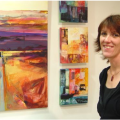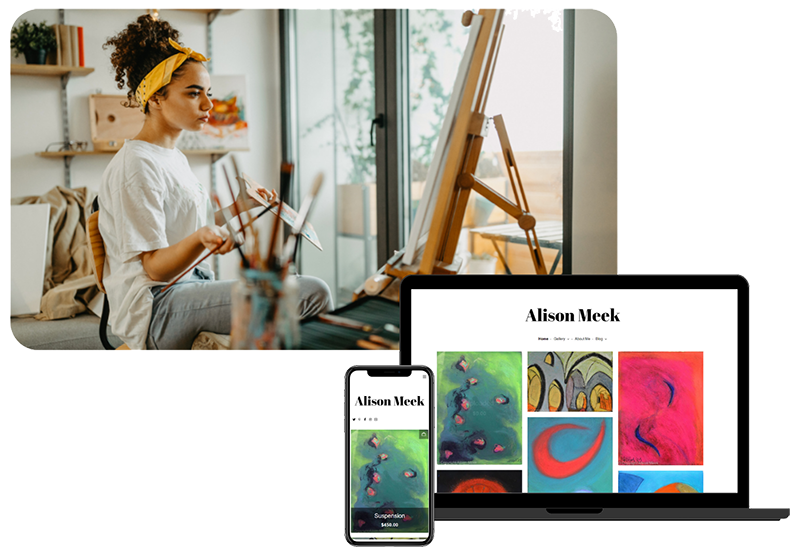The About Me page of an artist website manages to compress in one diabolical location many of an artist’s least favorite tasks: writing, boasting and web design.
Creating the perfect artist website can feel like an impossible task. Whether you want to build an e-commerce store or simply create an online gallery for your work, you know that a stunning website is key to your professional success. And among the “must have” elements for your website is a biography or “About Me” section.
After all, art lovers don’t just buy a canvas or a hunk of clay. They buy a story — your story. They want to understand the meaning of your work, it’s motivation. When they envision their future heirloom, they imagine telling their grandchildren the story of the charming artist who created it.
Your About Me page really is that important.
Fortunately, creating a compelling About Me page for your website doesn’t require an army of writers or web designers. You can DIY your way to a one-of-a-kind About Me page that tells your story, showcase your artistic vision and sells your work.
For two decades, Artweb has been helping artists build gorgeous, no stress websites on a budget. In that time, we’ve developed four simple building blocks to create the perfect About Me page: the portrait, the tagline, the bio and the resume.
Read on to learn the expert tips on how to create the perfect web introduction to you and your work.

Show off
Creating your about me page is a chance to sell yourself. Start with the basics.
Your about me page should be succinct, and aimed at all levels of an audience. The best sites are inclusive, showing potential buyers it’s okay to just like the work, without having to understand it. If words don’t come easily, you can use your artist statement as a starting point.
For inspiration, check out our guide to writing the perfect artist statement.
The photograph
A photograph of the artist is a chance to showcase your personality. This is not a passport, ID or driver’s license. So don’t just pull out a head and shoulders photo you have hanging around and upload it. It really is worth spending some time and possibly some money on a shot that is eye-catching, thought-provoking and captures you as an artist. That doesn’t mean glam. You don’t need hair and make-up. Just like weddings, the best pictures are often the candid ones.
Fortunately, the image you create has many lives beyond the About Me page of your website. Repurpose it for social media posts, exhibition catalogues or publicity campaigns. Find out more about how to promote yourself on How to Publicize Your Art – seven different tricks.
Below are a few ideas from artists who used their website photos to really stand out.
A Self Portrait is worth a thousand words
If you are a portrait artist, consider using a painted portrait of yourself. Opt for an image that conveys your likeness, but also offers psychological complexity and a window into your artistic style. Depending on your aesthetic sensibility, avoid creating a portrait that exaggerates flaws or repels viewers. You are, after all, trying to sell art on your website.

The Artist at Work
If you are lucky enough to have a studio or share a co-op space, take photos of you at work. First, curate the space. Think about what you want potential buyers to see. If you have ever held an open studio, how did you present your space?
Stacks of cardboard boxes and rolls of bubble wrap may be necessary, but they won’t tell your viewer anything, except whether you are tidy.
Instead, display work in its various stages of creation. Make sure there is plenty to see at different eye levels. Completed work on shelves or walls, work in progress on tables and – most importantly – you.
Facing the camera or posing at work, either will work well. Make sure there is good lighting and use a high-quality camera that will capture all the detail in sharp focus. Find out more about taking great photos for your website here.

If you don’t have a suitable studio space, have someone photograph you next to your artwork.
The image of the artist at work creates instant credibility. Moreover, it shows you’re passionate about your work. As an added bonus, if the work pictured is also for sale, you can link directly to your shop.
Consider using several photos. Modern website builders like Artweb offer carousel settings which allow the viewer to flick through several images, or gallery images that create a photo montage.
Writing your About Me page
It’s normal to experience writer’s block when trying to write copy for your website. Here’s a few questions to get your started.
- What materials and processes do you use and why?
- Who and what are your influences? How have these affected your work?
- How have you and your work developed over time?
Quotations and straplines
Beginning with a quote can grab your visitor’s attention. Even more so if you use a pull quote design that sets it apart from the rest of the text. The quote should be yours and it should be definitive. Don’t be vague or uncertain. Avoid: I try, I think, my aim is to, You should be categorical, my work is, I am, it is. Otherwise, a buyer might wait until you’ve got it right before making a purchase. You are conveying (not trying to convey) the fundamental elements of what your work is about.
Some of the great artists were exceedingly good at summing up their work in a soundbite. The great August Rodin did it in five words: “I invent nothing, I rediscover.” Now put those words against his work. Do they give a sense of what he creates?
This time in under 10 words: “Color is my day-long obsession, joy and torment,” says the great landscape colorist Claude Monet. We read that quote and see the work, and we are not surprised at his torment. They are a perfect match.

Sell yourself – write a great biography
Your biography should follow a brief introduction to your work. After all, this web page is called “about me.” It’s your biography and you can choose to include whatever you want. Don’t pass up a chance to boast!
Many artists struggle with self-promotion. Understandably, you may feel uncomfortable listing achievements and successes. However, we all know how important it is to sell yourself, especially when trying to sell your work. Focus on the parts of your life that you are most proud of. For example, if you feel you’ve had a great education, elaborate on how it contributed to your art. If you studied under renowned artists, explain what they taught you. Where you grew up, your influences, and where you’ve lived can all contribute to a compelling biography.
Your biography is a chance to talk about YOU and not just your professional achievements. As a guide you can include:
- Education
- Noteworthy exhibitions
- Awards or shortlists
- Artist’s collectives you might be part of
- Future shows and commissions
- Reviews (positive ones, of course)
- Inclusion in collections – private and public
- Relevant personal history
If you are still struggling, use our artist’s question and answer template.
The artist’s resume
Your resume can act as an extension of your biography. It’s an opportunity to list all of your achievements in detail. It’s part of your About Me page but will be more detailed. In all likelihood, your resume will be most interesting to people looking to make a commission or a gallery considering you for a show. Think about what they would want to know and what you need to share to convince them!
If you feel a resume on top of your statement and biography would clutter your About Me page, you can create a separate page. Alternatively, you can include a link to a downloadable PDF. Either way, Artweb offers templates specifically for artists, as well as a drag-and-drop editor. Together, they let you build both types of pages in minutes without having to overthink formatting.

The four building blocks of a good artist’s resume
It doesn’t have to take days to create a resume that tells the story of your background, motivations and accomplishments. Just include these four basic components:
#1: Your Basic Information
At the top of your resume, include who you are and where people can find you:
- Your name
- Medium (e.g. painter, sculptor, mixed media artist)
- Place of residene (state, city or town)
- Year and place of birth (some artists include these, but it’s optional)
- Your contact information (if you opt for a downloadable resume)
#2: Education
Include your education in date order, most recent first. If you have pursued further or higher education, don’t include high school unless it’s relevant to your work.

#3: Exhibitions and commissions
Within your About Me section, the meat of your resume will feature your exhibitions, commissions and awards. These bona fides signal your success within the artworld. If you are just starting out, the list may be short, but that’s ok. Even if you’ve only shown your work at an open exhibition, graduate show or community art center, you should shout about it!
List exhibitions by year. Each listing should give the name of the show, its location (gallery name and city/state) and whether it was a solo or group show.
Further, don’t forget to include other important milestones:
- Details of residencies
- Awards won and any you have been nominated or shortlisted for
- Selected commissioned work
- Collections that hold your work – both public and private
- List of any work that has been published in books, or articles written about you, along with the related images

#4: What the critics said
Finally, your resume or About Me section can include comment from critics and published reviews (the positive ones, of course). Consider the effect of a five star review on movie posters and Tripadvisor. Personal recommendations can help push people into thinking your work is worthy of purchase or exhibition. If your work has yet to be reviewed, consider using something from your college or university transcript. If you are using a quote, ensure it is fully credited, get permission if you can, and ensure it has full context.
Creating a Standout About Me Page Doesn’t Have to be Hard
If you follow these simple steps, you can DIY your way to a professional About Me page that captures your artistic vision and helps you sell your art.
And, if you’re wondering how to build your very own artist’s website without the stress or expense, consider building a free website with Artweb.







